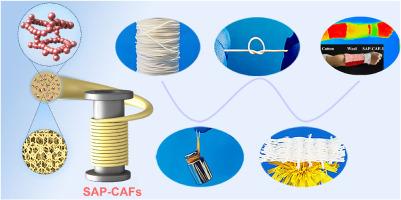Robust and elastic composite aerogel fiber constructed from three-dimensional embedding of silica aerogel particles in nanoporous agarose
IF 4.1
2区 化学
Q2 POLYMER SCIENCE
引用次数: 0
Abstract
Aerogel fibers inherit the advantages of the aerogel and fiber materials, such as good flexibility, low density, and high porosity, and are promising for producing wearable thermal insulation textiles for harsh environments. Nevertheless, the practical application of the three-dimensional (3D) network structures of aerogel fibers is hindered by their poor mechanical properties owing to the nanoporous structure. In this work, we produced composite aerogel fibers (CAFs) by combining SiO2 gel slurry derived from coal fly ash with agarose and polyurea using wet-spinning and supercritical-drying technologies. In the CAFs, small SiO2 aerogel particles existed in agarose nanofiber network to form an embedded structure. The synergic effects between the fragile SiO2 gel skeleton and soft agarose nanofiber gel skeleton endow the CAFs with excellent elasticity, showing considerable of elastic recovery even after radial compression under 40 % strain, thus also helping to overcome some limitations of fragile SiO2 aerogels and soft agarose nanofiber aerogels in practical applications. Surface modification of aerogel fiber with polyurea not only endows it with ideal hydrophobicity (water contact angle: 130°), but also enhances its tensile resistance (∼2.5 MPa). Furthermore, the aerogel fibers exhibit high specific surface area (∼182 m2/g) and low thermal conductivity (0.027 W m−1 K−1). Hence, this study constructs the microstructure of silica embedded in the agarose fiber network to obtain SiO2/agarose/polyurea CAFs (SAP-CAFs) with excellent performance, which will promote their application in the field of clothing fabrics in extreme temperature and humid environments.


在纳米多孔琼脂糖中三维嵌入二氧化硅气凝胶颗粒构建的坚固弹性复合气凝胶纤维
本文章由计算机程序翻译,如有差异,请以英文原文为准。
求助全文
约1分钟内获得全文
求助全文
来源期刊

Polymer
化学-高分子科学
CiteScore
7.90
自引率
8.70%
发文量
959
审稿时长
32 days
期刊介绍:
Polymer is an interdisciplinary journal dedicated to publishing innovative and significant advances in Polymer Physics, Chemistry and Technology. We welcome submissions on polymer hybrids, nanocomposites, characterisation and self-assembly. Polymer also publishes work on the technological application of polymers in energy and optoelectronics.
The main scope is covered but not limited to the following core areas:
Polymer Materials
Nanocomposites and hybrid nanomaterials
Polymer blends, films, fibres, networks and porous materials
Physical Characterization
Characterisation, modelling and simulation* of molecular and materials properties in bulk, solution, and thin films
Polymer Engineering
Advanced multiscale processing methods
Polymer Synthesis, Modification and Self-assembly
Including designer polymer architectures, mechanisms and kinetics, and supramolecular polymerization
Technological Applications
Polymers for energy generation and storage
Polymer membranes for separation technology
Polymers for opto- and microelectronics.
 求助内容:
求助内容: 应助结果提醒方式:
应助结果提醒方式:


